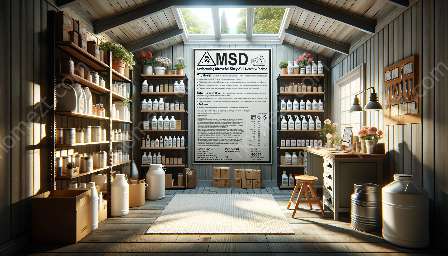hazardous materials have become an integral part of modern life, as they are used in various industries and households. While these materials offer many benefits, they can also pose significant risks to human health. The improper storage and handling of hazardous materials can lead to exposure, resulting in adverse health effects. It is crucial to understand the impact of hazardous materials on human health and how to ensure safe storage to mitigate these risks. This topic cluster will delve into the implications of hazardous materials on human health, explore safe storage solutions, and consider the broader context of home safety and security.
Hazards of Hazardous Materials
Hazardous materials encompass a wide range of substances, including chemicals, radioactive materials, biological agents, and more. These materials can lead to various health hazards, such as acute toxicity, carcinogenicity, mutagenicity, and reproductive toxicity. Exposure to hazardous materials can occur through ingestion, inhalation, or skin contact, and the effects can range from mild irritation to severe illness or even death.
Impact on Human Health
The impact of hazardous materials on human health can be far-reaching. For example, exposure to toxic chemicals can lead to respiratory problems, skin disorders, or neurological disorders. Long-term exposure to certain hazardous materials may also increase the risk of developing chronic health conditions, such as cancer or organ damage. Additionally, certain hazardous materials, such as asbestos or lead, have been linked to serious health issues, including mesothelioma and lead poisoning.
Safe Storage of Hazardous Materials
Proper storage of hazardous materials is essential to minimize the risk of exposure and protect human health. This includes storing hazardous materials in designated containers, ensuring proper labeling and segregation, and implementing appropriate ventilation and containment measures. It is also crucial to follow safety guidelines and regulations when handling hazardous materials, as well as to regularly inspect and maintain storage facilities to prevent leaks or spills.
Home Safety & Security
When it comes to household hazardous materials, such as cleaning agents, pesticides, and batteries, it is important to consider home safety and security. This includes keeping hazardous materials out of reach of children, storing them in secure cabinets or areas, and being mindful of potential interactions between different products. Furthermore, educating household members about the proper use and storage of hazardous materials can help prevent accidents and promote a safer living environment.
Conclusion
The impact of hazardous materials on human health is a complex and critical issue that requires careful consideration and proactive measures. Understanding the potential hazards of these materials, implementing safe storage practices, and prioritizing home safety and security are essential steps in safeguarding human health and well-being. By raising awareness and promoting responsible management of hazardous materials, we can minimize the risks and create safer environments for ourselves and future generations.



